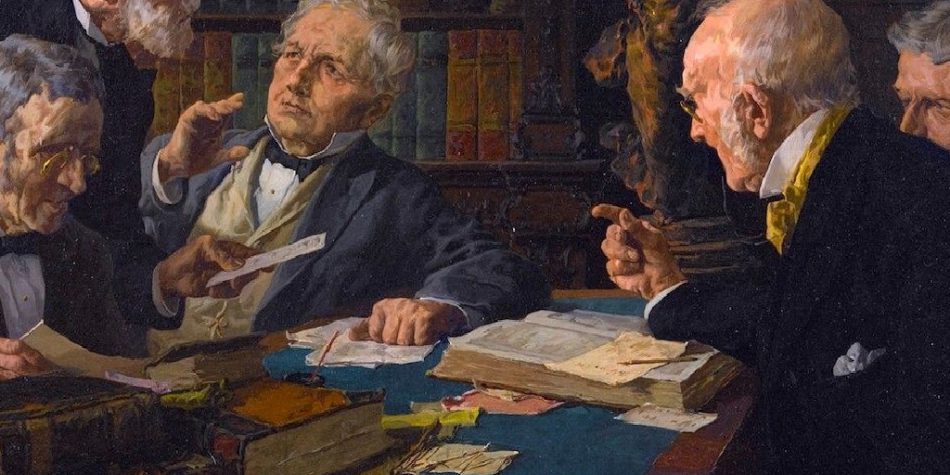Years ago, I embarked on a project to help facilitate a “more productive” conversation between religious conservatives and the gay community. Through a series of articles targeting key disagreements between these communities, I hoped to encourage more heartfelt dialogue with the highest likelihood of leaving people on both sides with greater insight, empathy—and yes, a stronger grasp on the “whole truth” of what was happening.
Boy, was I naïve. Compared with other interests, a broader picture of truth didn’t seem to be something many people seemed all that interested in—let alone the chance to hear out different perspectives on these important questions. That was very apparent in the largely disinterested response to my “come, let’s talk better” entreaties. Over time it became clear that most people were driven and drawn towards something else.
Framing conversation to advance an idea. I was forced to eventually realize that the national conversation about LGBT+ issues was not really aimed at the open exchange of competing thoughtful perspectives on the meaning of love, identity, sexuality, etc. If it was, we would have all been more intently focused on promoting questions that invited sharing across our important differences, such as, “so what does love mean to you?” OR “help me to understand how you see identity?”
Instead, as we all know, people over the last decade have been inundated with a very different set of questions: “Do you love people, or not?” “Will you accept me for who I truly am, or not?” “Do you care about civil rights, or not?” “Is your organization committed to inclusivity … or not?”
Can you see the difference between these two sets of questions and where they lead? Compared with the first set, where one might be genuinely surprised to hear different answers, the second set of inquiries reflects what Charles Taylor once called “pseudo-questions”—assertions masquerading as questions. It’s hard to overstate just how much the national and international conversations about sexuality, identity and marriage has been shaped by these largely unquestioned terms. Laws have been passed, churches have been pressured, and momentous individual decisions about family and future have all been made under their influence.
As many of us have finally come to realize, these popular and pervasive questions seem designed not to seek greater truth or promote deeper understanding, but instead to advance a particular socio-political agenda. All this was a surprise to me at the time, but it shouldn’t have been. Because I had witnessed something very similar once before.
Framing conversation to advance a particular product. In the decade prior, I studied the discourse around depression and antidepressants for my dissertation research. As normal as it has been to hear of “fighting stigma,” “decreasing treatment access,” and educating people about “chemical imbalances”—I was surprised to learn how each of these familiar slogans had been initially developed by companies trying to sell a particular product (and disseminated through mental health “educational” organizations funded by these same companies). Rather than simply trying to “help people” or to “seek more truth” about mental illness, the particular terms of our dominant mental health conversation has been demonstrably and effectively leveraged (and designed) to advance a particular product line (for more on this, see Dr. Jeffrey Lacasse’s “Antidepressants and the Chemical Imbalance Theory of Depression” or my own essay with Jeff and two others, “A Dialogue About the U.S. Dialogue on Mental Health”).
It was in my interviews with people describing their experiences with depression that the practical effect of these kinds of Pharma-friendly biases became most apparent. One woman I interviewed recounted having a panic attack soon after starting Zoloft, and telling her friend that this medication was “making me have panic attacks!” Her friend responded, “It’s not the medication, it‘s your anxiety that you want this to work so bad.” Uneasy about this response, this woman checked with her doctor, who likewise insisted that her underlying anxiety, not the drug, was the problem. Subsequently, instead of tapering her off the antidepressant, an antianxiety medication was prescribed as well.
Can you spot the strong bias? To this friend and the doctor, it seems clear the drug could not have been the problem. Should that possibility have been completely off the table? (a later 2014 study confirmed that after taking antidepressants for a short time, approximately 7% of participants developed antidepressant-induced jitteriness/anxiety syndrome, up to and including panic attacks).
Obscuring real possibilities. This is one of the more classic example of pro-pharmaceutical bias in real life. As psychiatrist Peter Breggin first pointed out, whenever someone has a positive experience while taking psychiatric medication, our tendency is to give the drug credit and praise. But when someone suffers a downturn or unfortunate new episode of mental distress following psychiatric treatment, that’s almost always attributed to underlying pathology, and not (or hardly ever) to the drug itself.
Again, it’s hard to overstate just how thoroughly our past and present conversations about mental health have been shaped by these kinds of larger unquestioned presumptions. Government and church policies, awareness campaigns, and treatment regimens have all taken these larger framings for granted. And when, in recent years, rates of depression, anxiety and suicide have reached historic levels, perhaps the most telling indicator of the power of this broader framework was that for most community leaders and legislators, re-thinking our starting points wasn’t even on the table. Rather, the central question continued to be “how best to promulgate the same approaches to treatment to even more people.”
Once you start paying attention to all this, the real-life consequences of this kind of bias become obvious. Can you also see the way our dominant mental health conversation can limit the extent to which participants (who have embraced its terms) see all the possibilities?
To my mind, that’s a serious problem, and not just because of the personal consequences for individuals and families. What about our basic ability to reach for a broader understanding of truth together? That’s why Randall Paul, Arthur Peña, and I took up this same question a year ago in considering whether certain popular American conversations were impossibly “pre-loaded for failure.” Even when these frameworks for conversation (about sexuality or mental health) are shot-through and driven by certain agendas, most people who enter these conversations presume a good-faith, honest discussion between people seeking to “help gay people” or “support the mentally ill.”
Do we see any application to the conversation we continue to have about COVID-19 and the best way to respond to this continuing threat?
Another heavily weighted discourse. Are the terms of our prevailing pandemic conversation set up in a way that we can trust the full truth to be clearly known? This is the question I’ve been thinking about and discussing lately with people in my own community: Is this larger American pandemic conversation one that we should be trusting so much?
Many of my friends, and brothers and sisters of faith sure think so. In conversation with them over these many months, I’ve learned the extent to which many remain confident in the trustworthiness of pronouncements being made by official organizations and groups of experts.
After all, how can so many experts—saying the same things—be wrong?
Of course, there are many other cases in which consensus expert opinion flies in the face of inspired doctrine and Christian teaching. In this instance, though, there has been an alignment between the sentiment of many wonderful religious leaders and popular views.
Lest you get irritated at my line of questioning, may I remind you, my primary focus here is not on what is, in fact, “the whole truth”—even though that’s a critically important question. My interest here is more modest—drawing attention simply to whether our current American conversation about COVID-19 (like other important questions touched on earlier) is set up and predisposed to point us towards the full truth of the matter.
And I’m about to explain why I believe it is not. To those who see the abundance of professional expertise and scientific reports around us as sufficient to confirm what is true—and continually reveal anything else we need—I would first press you to consider a caution by Albert Einstein, who once stated, “Science can flourish only in an atmosphere of free speech.” (Aaron Rodgers raised a similar concern recently, “If science can’t be questioned, it’s not science.”)
Why should this be a concern? Because without the open scrutiny of competing perspectives, the possibility of seeing and discovering new truths is greatly reduced. Right?
Even if you’re fully on board with public health orthodoxy today, you can probably agree we’re far removed from that kind of open inquiry and freedom today in our public discourse—with impassioned rationales heard virtually everywhere you go for how crucial it is to limit “misinformation” that might lead people wrong.
Most people now believe such misinformation represents a grave threat to public health. They wring their hands worrying about why Facebook hasn’t done MORE to limit misinformation on its platform (which for some of us wins first place in a competition of “sentences that confirm we’re starting to live in a dystopian novel” after witnessing sweeping censorship become the norm over the last year, including hundreds of major Facebook pages about health being deleted for daring to raise questions about popular medical assumptions).
Even so, many Americans—Christians included—feel nothing but gratitude for the fact-checkers and censors working day and night to ensure YouTube, Facebook, and Twitter remain undefiled from any dangerous dissent that might provoke even more critical scrutiny and questioning. For so many people, all this contributes to a discourse they trust to confirm truth—namely, one where challenges to the expert consensus are minimized, so that the public may consume without qualm their guidance and direction.
But what about the experts? Aren’t they free to debate and share their ideas? Hardly. You don’t need to go very far to see the harsh punishments that have rained down on doctors, researchers, and public health officials that dare betray the official narrative.
And therein, my brothers and sisters, lies the greatest stumbling block to the idea our American conversation is well-positioned to reveal truth. Since when did we think this set-up (advancing one particular view of healing and infectious disease management and actively censoring all the rest) could be any sort of pathway to honest accountability to the full truth, let along disruptive discoveries and ground-breaking insights—aka, “further light and knowledge”?
Of course, it cannot—unless, by further light and knowledge, we mean further elucidation of what we have already concluded must be true.
But what if that conclusion is wrong? I conclude this article with one concrete case example demonstrating how strong health convictions in our day may actively obscure an appreciation of plain truths that could otherwise be openly acknowledged.
The New York nursing home. One nursing home in Auburn, New York, back in December 2020, began vaccinating residents on the 22nd—three days before Christmas. One hundred ninety-three elderly residents (80%) received the shot. Up till that week, “there had been no nursing home Covid-19 deaths in Cayuga County.”
Yet on December 29th, one week after the mass inoculation, this nursing home reported three deaths—with 21 more deaths the week after, and three hospitalizations.
For our purposes, here’s the key question: how would you recognize a truth-oriented conversation about this tragic turn of events? What kinds of inquiry and hypotheses would you expect to see? And what kinds of questions would need to be asked?
Clearly, you’d have to take a look at the most obvious one: why did 24 residents die almost immediately after receiving vaccinations—when no one had died from COVID-19 in the same nursing home many months up to that moment?
Remarkably enough, the primary article reporting on this nursing home doesn’t even mention the possibility—instead, framing this entirely as a tragic outbreak of the virus that had taken place—without investigating the possible connection at all. Read it yourself: Covid-19 outbreak at Auburn nursing home infects 137 residents, kills 24.
That’s what happens when we become so convinced of a truth that our pursuit of journalism becomes bounded by its presumptions. My colleague Christopher Cunningham wrote up a similar case of selective journalism for the Deseret News last year—something that (regardless of your particular views) should be of concern to us all.
As striking as this New York example is, it’s hardly an outlier when considering the reporting that has taken place over the last two years. In virtually every instance of potential vaccine injury, the almost immediate response by media and public health officials has been to minimize the possibility of any such connection: “this is only anecdotal…all these are unverified…who knows if it was really linked at all?”
Pointing this out is not to engage in conspiracies. It’s a simple observation of what we’ve all witnessed. That’s why even Utah’s Senator Mike Lee has raised concern about “the widespread lack of acknowledgement of adverse events following receipt of a COVID-19 vaccination.” (For more on this, see my essay, “Stories We Tell About Side Effects“).
Seeing through the glass darkly. To reiterate: if the prevailing public health argument turns out not to be true, and mass vaccination is not the pandemic deliverance we had anticipated, will we be able to see that clearly? If, God forbid, there have turned out to be, in fact, longer-term unintended (and uncounted) consequences unbeknownst to us all the many months before when Pfizer declared “95% effectiveness” for adults and “safe and effective” for children, then I would ask again: under the terms of our prevailing public health conversation, would we—could we—come to see clearly this emerging evidence accurately to help us reach that determination?
I struggle to see how we could. Does anyone believe that any of these professional organizations and national campaigns so single-mindedly focused on advancing one particular health philosophy would ever reach that conclusion, let alone the companies creating these vaccines?
Similar to the antidepressant narrative, it’s built into our larger American conversation that vaccination cannot be the problem. In the event things don’t go according to plan (as we’re seeing of late), our public conversation is not primed to consider every conclusion equally. For instance, if there is anyone to blame, we already know where that must fall: to those refused the vaccine.
Regardless of what you feel about COVID-19 vaccination, I’m arguing that our popular discourse is not currently set up to register and reveal the full (especially longer-term picture) of the effects of these health interventions—not simply because it is stifling free debate among normal people, but because it is also silencing (or punishing) any doctors and scientists who have dissenting views.
For that reason, I believe our American conversation is designed to defend vaccination at all costs.
Regardless of what is true.
You might disagree; if you do, I hope to hear from you in the comments. Certainly, this is a question I would hope is of significant concern to us all. Lest you accuse me of being one of those dirty purveyors of misinformation, I remind you I’m making my case here for something everyone should be able to embrace: a discourse where the full truth can be known.
Even so, I recognize that I’m raising a question that may be unsetting to people. Want to hear what’s even more unsettling? Facing this mounting pandemic crisis around us without asking questions like I’m posing (and instead, calling people who do nasty names).
If prevailing public health conclusions are exactly right, of course, none of this should cause much concern. But if they’re off—a little or a lot—the American people, I believe, are not well-positioned to find that out and discern the full picture of what’s happening.
That doesn’t mean we can’t. It just means we should maybe not be so quick to rely on mainstream media sources and health officials (with a track record of attempting to silence any dissent from official positions) to help us do it.

















